Apps
Auto Added by WPeMatico
Auto Added by WPeMatico
Facebook’s dedicated Gaming app is now live on Android, months before its planned June release. The social media giant pushed the app out two months prior to its scheduled unveiling amid a global pandemic that’s left people all over the world isolated at home, rapidly burning through entertainment options.
The New York Times announced the upcoming release in an exclusive over the weekend, noting that Facebook’s massive gaming investment has culminated in more 700 million of the sites’s 2.5 billion users actively playing games through the platform monthly. The launch of a devoted app is a clear next step for content that has, until now, been the domain of the site’s Gaming tab.
Social engagement is the focus for the app (naturally), which will be getting an iOS version at some point in the near future (pending Apple approval). “It’s entertainment that’s not just a form of passive consumption but entertainment that is interactive and brings people together,” the app’s head Fidji Simo told the paper, later adding, “We’re seeing a big rise in gaming during quarantine.”
Twitch and YouTube are among the biggest competitors for the app’s gaming Go Live streaming feature. Facebook has already has a massive platform in its own Live offering, which is currently seeing high levels of use as isolated users seek some manner of human connection during the COVID-19 shutdown. With Go Live, users can share gaming streams directly to their Facebook page.
Live streaming is the highlighted feature upon launching the app, while a second tab offers game discovery both through your friends’ activities and a by category breakdown. A final tab sports a chat platform.
The app’s arrival comes after a year and a half of testing in various markets, including Latin America and Southeast Asia. Gaming is launching without ad support, though Facebook tells the Times that it plans to monetize by taking commission off of “stars” — donations viewers send to streamers.
It remains to be seen how the Twitch/YouTube method will translate for a platform traditionally more focused on casual gaming titles like Words With Friends. Not all of the service’s attempts to spin off features as devoted apps have been successful, but the rushed timing could give the service an extra boost, as users seek out new forms of content and socializing during a global shutdown.
Powered by WPeMatico
Meet Leverice: A team messenger and collaboration platform that’s aiming to compete with b2b giants like Slack by tackling an issue that continues to plague real-time messaging — namely, ‘always-on’ information overload. This means these tools can feel like they’re eating into productivity as much as aiding it. Or else leave users stressed and overwhelmed about how to stay on top of the work comms firehose.
Leverice’s pitch is that it’s been built from the ground up to offer a better triage structure so vital bits of info aren’t lost in rushing rivers of chatter than flow across less structured chat platforms.
It does this by giving users the ability to organize chat content into nested subchannels. So its theory is that hyper structured topic channels will let users better direct and navigate info flow, freeing them from the need to check everything or perform lots of searches in order to find key intel. Instead they can just directly drill down to specific subchannels, tuning out the noise.
The overarching aim is to bring a little asynchronicity to the world of real-time collaboration platforms, per co-founder and COO Daniel Velton.
“Most messaging and collaboration tools are designed for and built around synchronous communications, instant back-and-forth. But most members of remote teams communicate at their own pace — and there was no go-to messaging tool built around asynchronous communications,” he tells TechCrunch.
“We set out to solve that problem, to build a messenger and collaboration platform that breaks rivers down into rivulets. To do that, we needed a tech stack and unique architecture that would allow teams to efficiently work with hundreds of channels and subchannels distributed between scores of channel branches of varying depths. Having that granularity ensures that each little shelf maintains topical integrity.
“We’re not discussing Feature 2.1.1 and 2.1.2 and 2.1.3 and 2.1.4 inside a single ‘Features’ channel, where the discussions would blend together. Each has its own little home.”
Of course Slack isn’t blind to the info-overload issues its platform can generate. Last month it announced “a simpler, more organized Slack”, which includes the ability for users to organize channels, messages and apps into “custom, collapsible sections”. Aka folders.
So how is Leverice’s subchannel architecture a great leap forward on the latest version of Slack — which does let users organize themselves (and is now in the process of being rolled out across its user-base)?
“All structuring (including folders) on other popular messengers is essentially an individual preference setting,” says Velton. “It does not reflect on a teamwide channel tree. It’s definitely a step in the right direction but it’s about each user adding a tiny bit of structure to their own private interface, not having a structure that affects and improves the way an entire team communicates.
“Leverice architecture is based on structuring of channels and subchannels into branches of unlimited depth. This kind of deep structuring is not something you can simply ‘overlay’ on top of an existing messenger that was designed around a single layer of channels. A tremendous number of issues arise when you work with a directory-like structure of infinite depth, and these aren’t easily solved or addressed unless the architecture is built around it.”
“Sure, in Leverice you can build the ‘6-lane autobahns’,” he adds, using an analogy of vehicle traffic on roads to illustrate the concept of a hierarchy of topic channels. “But we are the only messenger where you can also construct a structured network of ‘country roads’. It’s more ‘places’ but each ‘place’ is so narrow and topical that working through it all becomes more manageable, quick and pleasant, and it’s something you can do at your own pace without fear of missing important kernels of information as they fly by on the autobahn.”
To be clear, while Slack has now started letting users self-organize — by creating a visual channel hierarchy that suits them — Leverice’s structure means the same structured tree of channels/subchannels applies for the whole team.
“At the end of the day, for communications to work, somebody on a team needs to be organized,” argues Velton. “What we allow is structuring that affects the channel tree for an entire team, not just an individual preference that reflects only on a user’s local device.”
Leverice has other features in the pipeline which it reckons will further help users cut through the noise — with a plan to apply AI-powered prioritization to surface the most pressing inbound comms.
There will also be automated alerts for conversation forks when new subchannels are created. (Though generating lots of subchannel alerts doesn’t sound exactly noise-free…)
“We have features coming that alert users to forks in a conversation and nudge the user toward those new subchannels. At this stage those forks are created manually, although our upcoming AI module will have nudges based on those forks,” says Velton.
“The architecture (deep structuring) also opens the door to scripting of automated workflows and open source plug-ins,” he adds.
Leverice officially launched towards the end of February after a month-long beta which coincided with the coronavirus-induced spike in remote work.
At this stage they have “members of almost 400 teams” registered on the platform, per Velton, with initial traction coming from mid-size tech companies — who he says are either unhappy with the costs of their current messaging platform or with distraction/burnout caused by “channel fatigue”; or who are facing info fragmentation as internal teams are using different p2p/messaging tools and lack a universal choice.
“We have nothing but love and respect for our competitors,” he adds. “Slack, Teams, WhatsApp, Telegram, Skype, Viber, etc.: each have their own benefits and many teams are perfectly content to use them. Our product is for teams looking for more focus and structure than existing solutions offer. Leverice’s architecture is unique on the market, and it opens the door to powerful features that are neither technically nor practically feasible in a messenger with a single layer containing a dozen or two dozen channels.”
Other differentiating features he highlights as bringing something fresh to the team messaging platform conversation are a whiteboard feature that lets users collaborate in the app for brainstorming or listing ideas, prorities; and a Jira integration for managing and discussing tasks in the project- and issue-tracking tool. The team is planning further integrations including with Zoom, Google Docs and “other services you use most”.
The startup — which was founded by CEO Rodion Zhitomirsky in Minsk but is now headquartered in San Jose, California, also with offices in Munich, Germany — has been bootstrapping development for around two years, taking in angel investment of around $600,000.
“We are three friends who managed complex project-based teams and personally felt the pains of all the popular messengers out there,” says Velton, discussing how they came to set up the business. “We used all the usual suspects, and even tried using p2p messengers as substitutes. They all led us and our teams to the same place: we couldn’t track large amounts of communications unless we were in “always-on” mode. We knew there had to be a better way, so we set out to build Leverice.”
The third co-founder is Dennis Dokutchitz.
Leverice’s business model is freemium, with a free tier, a premium tier, and a custom enterprise tier. As well as offering the platform as SaaS via the cloud, they do on-premise installations — for what Velton describes as “the highest level of security and privacy”.
On the security front the product is not end-to-end encrypted but he says the team is developing e2e encrypted channels to supplement the client-server encryption it applies as standard.
Velton notes these forthcoming channels would not support the usual search features, while AI analysis would be limited to “meta-information analysis”, i.e. excluding posts’ content.
“We don’t process customer or message data for commercial purposes, only for internal analytics and features to improve the product for users,” he adds when asked about any additional uses made of customer data. (Leverice’s Privacy Policy can be found here.)
With remote work the order of the day across most of the globe because of the COVID-19 pandemic, it seems likely there will be a new influx of collaboration tools being unboxed to help home workers navigate a new ‘professionally distant’ normal.
“We’ve only been on the market for 6 weeks and have no meaningful revenue to speak of as of yet,” adds Velton.
Powered by WPeMatico
Forget the calendar invite. Just jump into a conversation. That’s the idea powering a fresh batch of social startups poised to take advantage of our cleared schedules amidst quarantine. But they could also change the way we work and socialize long after COVID-19 by bringing the free-flowing, ad-hoc communication of parties and open office plans online. While “Live” has become synonymous with performative streaming, these new apps instead spread the limelight across several users as well as the task, game, or discussion at hand.
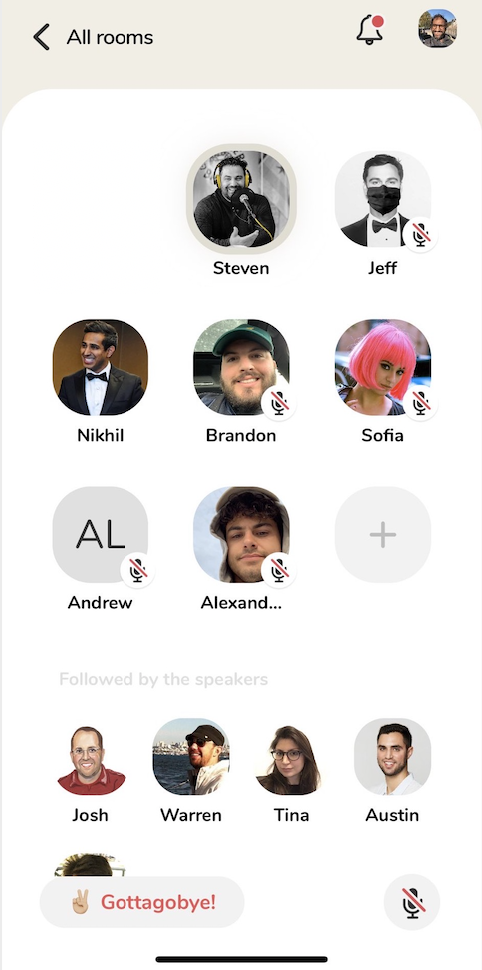 The most buzzy of these startups is Clubhouse, an audio-based social network where people can spontaneously jump into voice chat rooms together. You see the unlabeled rooms of all the people you follow, and you can join to talk or just listen along, milling around to find what interests you. High-energy rooms attract crowds while slower ones see participants slip out to join other chat circles.
The most buzzy of these startups is Clubhouse, an audio-based social network where people can spontaneously jump into voice chat rooms together. You see the unlabeled rooms of all the people you follow, and you can join to talk or just listen along, milling around to find what interests you. High-energy rooms attract crowds while slower ones see participants slip out to join other chat circles.
Clubhouse blew up this weekend on VC Twitter as people scrambled for exclusive invites, humblebragged about their membership, or made fun of everyone’s FOMO. For now, there’s no public app or access. The name Clubhouse perfectly captures how people long to be part of the in-crowd.
Clubhouse was built by Paul Davison, who previously founded serendipitous offline people-meeting location app Highlight and reveal-your-whole-camera-roll app Shorts before his team was acquired by Pinterest in 2016. This year he debuted his Alpha Exploration Co startup studio and launched Talkshow for instantly broadcasting radio-style call-in shows. Spontaneity is the thread that ties Davison’s work together, whether its for making new friends, sharing your life, transmitting your thoughts, or having a discussion.
It’s very early days for Clubhouse. It doesn’t even have a website. There’s no telling exactly what it will be like if or when it officially launches, and Davison and his co-founder Rohan Seth declined to comment. But the positive reception shows a desire for a more immediate, multi-media approach to discussion that updates what Twitter did with text.
What quarantine has revealed is that when you separate everyone, spontaneity is a big thing you miss. In your office, that could be having a random watercooler chat with a co-worker or commenting aloud about something funny you found on the internet. At a party, it could be wandering up to chat with group of people because you know one of them or overhear something interesting. That’s lacking while we’re stuck home since we’ve stigmatized randomly phoning a friend, differing to asynchronous text despite its lack of urgency.

Clubhouse founder Paul Davison. Image Credit: JD Lasica
Scheduled Zoom calls, utilitarian Slack threads, and endless email chains don’t capture the thrill of surprise or the joy of conversation that giddily revs up as people riff off each other’s ideas. But smart app developers are also realizing that spontaneity doesn’t mean constantly interrupting people’s life or workflow. They give people the power to decide when they are or aren’t available or signal that they’re not to be disturbed so they’re only thrust into social connection when they want it.
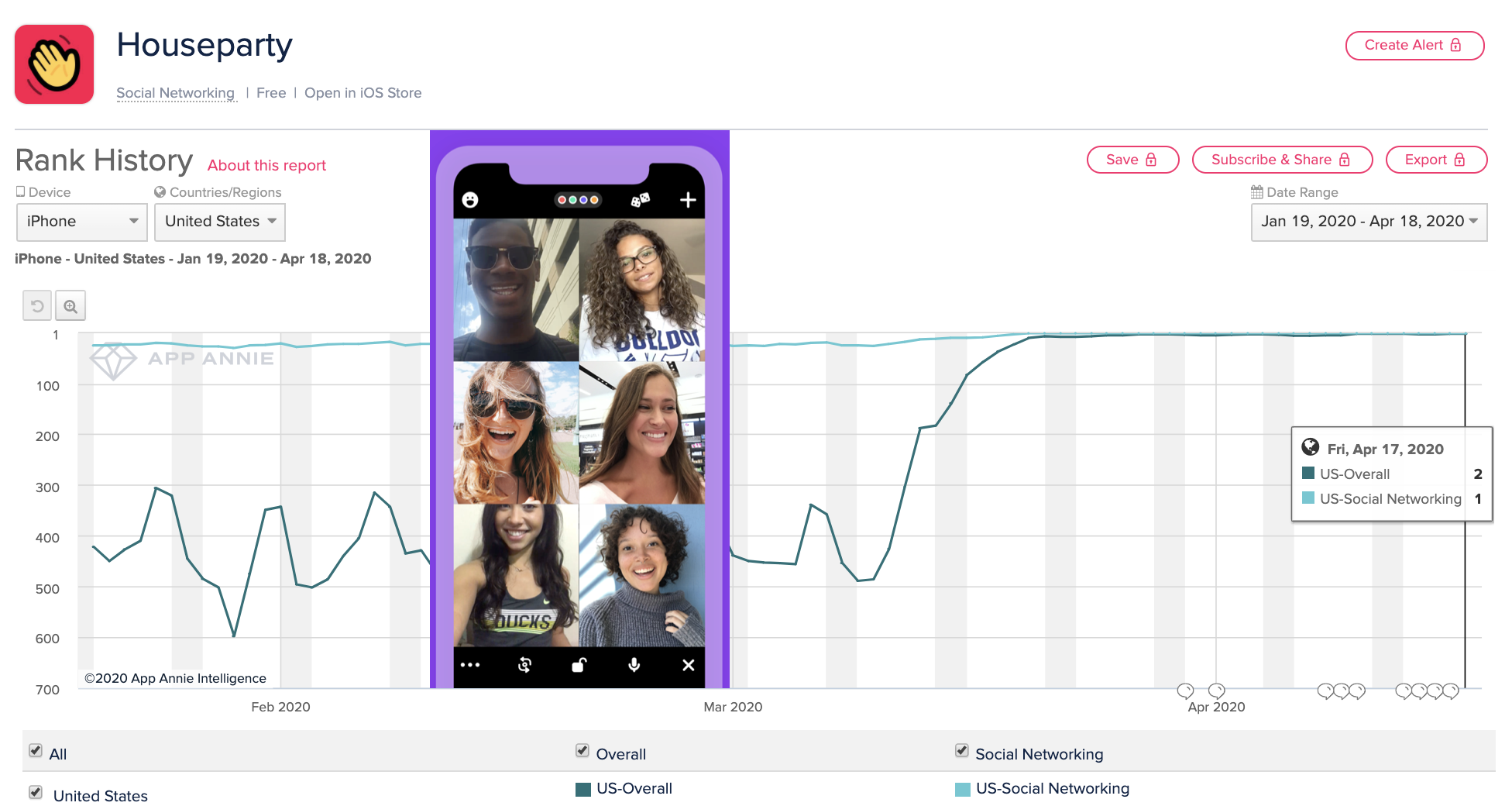
Houseparty chart ranks via AppAnnie
Houseparty embodies this spontaneity. It’s become the breakout hit of quarantine by letting people on a whim join group video chat rooms with friends the second they open the app. It saw 50 million downloads in a month, up 70X over its pre-COVID levels in some places. It’s become the #1 social app in 82 countries including the US, and #1 overall in 16 countries.
Originally built for gaming, Discord lets communities spontaneously connect through persistent video, voice, and chat rooms. It’s seen a 50% increase in US daily voice users with spikes in shelter-in-place early adopter states like California, New York, New Jersey, and Washington. Bunch, for video chat overlayed on mobile gaming, is also climbing the charts and going mainstream with its user base shifting to become majority female as they talk for 1.5 million minutes per day. Both apps make it easy to join up with pals and pick something to play together.

Enterprise video chat tools are adapting to spontaneity as an alternative to heavy-handed, pre-meditated Zoom calls. There’s been a backlash as people realize they don’t get anything done by scheduling back-to-back video chats all day.
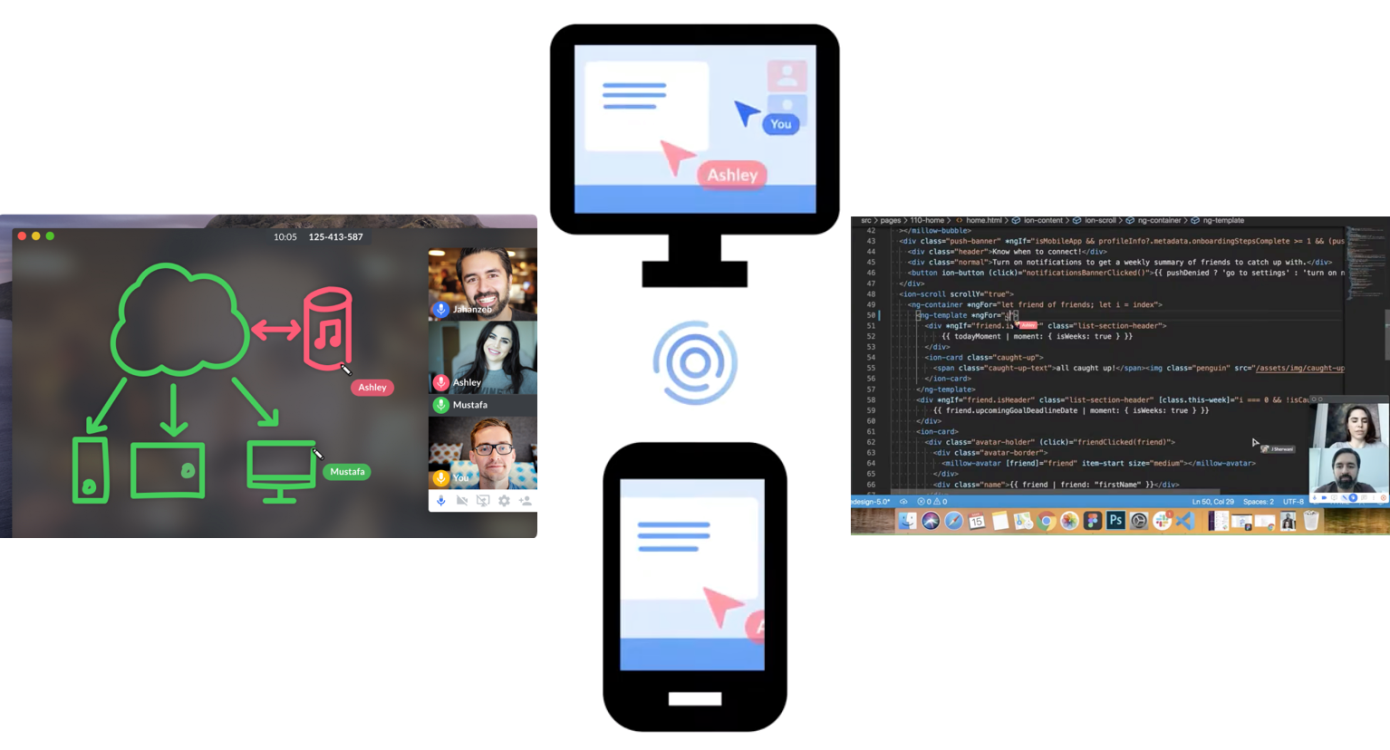
Screen
While visual communication has been the breakout feature of our mobile phones by allowing us to show where we are, shelter-in-place means we don’t have much to show. That’s expanded the opportunity for tools that take a less-is-more approach to spontaneous communication. Whether for remote partying or rapid problem solving, new apps beyond Clubhouse are incorporating voice rather than just video. Voice offers a way to rapidly exchange information and feel present together without dominating our workspace or attention, or forcing people into an uncomfortable spotlight.
High Fidelity is Second Life co-founder Philip Rosedale’s $72 million-funded current startup. After recently pivoting away from building a virtual reality co-working tool, High Fidelity has begun testing a voice and headphones-based online event platform and gathering place. The early beta lets users move their dot around a map and hear the voice of anyone close to them with spatial audio so voices get louder as you get closer to someone, and shift between your ears as you move past them. You can spontaneously approach and depart little clusters of dots to explore different conversations within earshot.
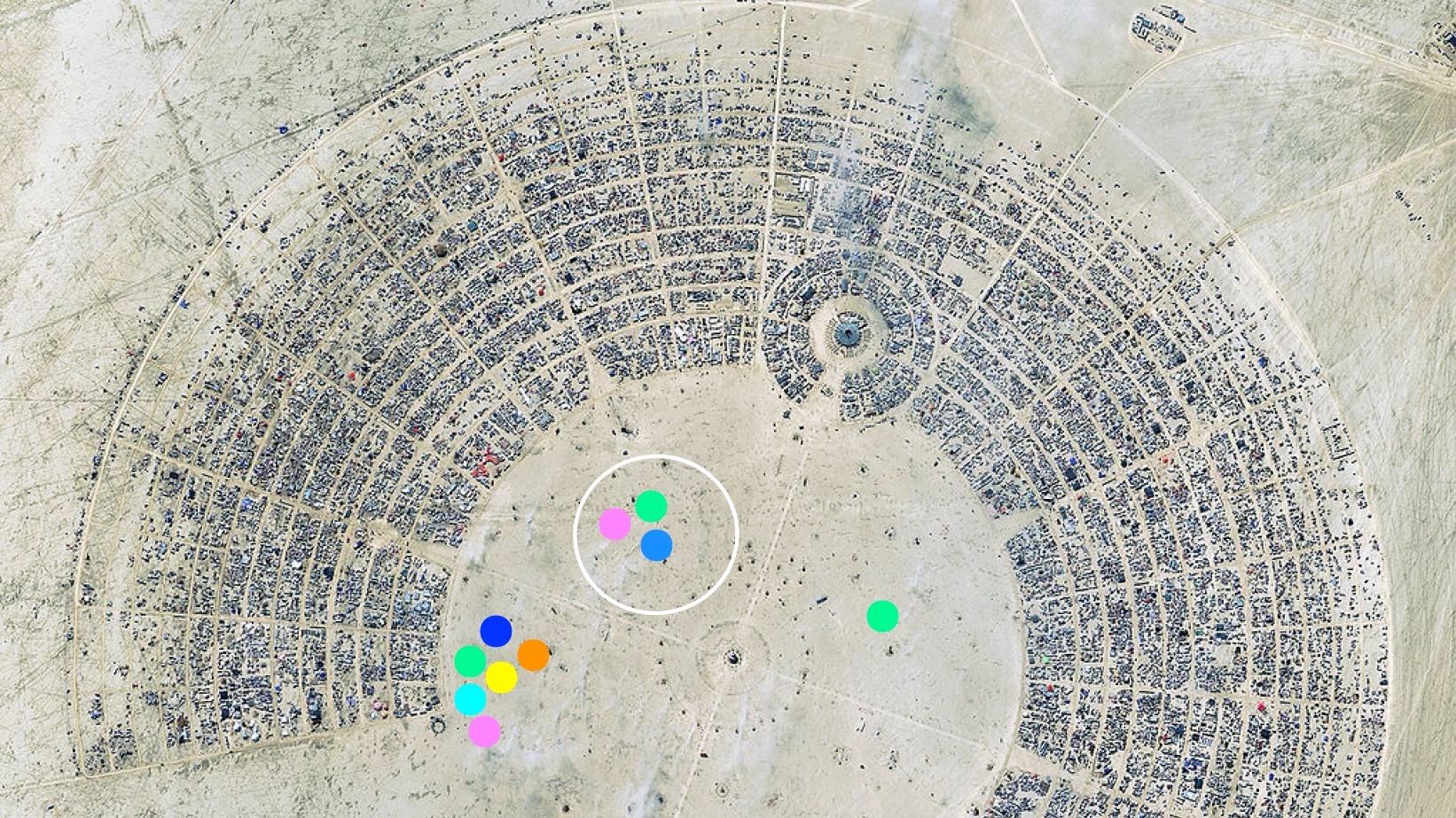
An unofficial mockup of High Fidelity’s early tests. Image Credits: DigitalGlobe (opens in a new window) / Getty Images
High Fidelity is currently using a satellite photo of Burning Man as its test map. It allows DJs to set up in different corners, and listeners to stroll between them or walk off with a friend to chat, similar to the real offline event. Since Burning Man was cancelled this year, High Fidelity could potentially be a candidate for holding the scheduled virtual version the organizers have promised.
Houseparty’s former CEO Ben Rubin and Skype GM of engineering Brian Meek are building a spontaneous teamwork tool called Slashtalk. Rubin sold Houseparty to Fortnite-maker Epic in mid-2019, but the gaming giant largely neglected the app until its recent quarantine-driven success. Rubin left.

His new startup’s site explains that “/talk is an anti-meeting tool for fast, decentralized conversations. We believe most meetings can be eliminated if the right people are connected at the right time to discuss the right topics, for just as long as necessary.” It lets people quickly jump into a voice or video chat to get something sorted without delaying until a calendared collab session.
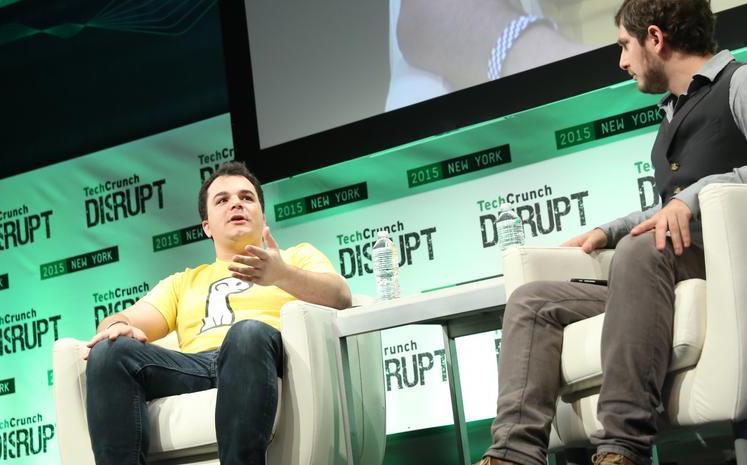
Slashtalk co-founder Ben Rubin at TechCrunch Disrupt NY 2015
Whether for work or play, these spontaneous apps can conjure times from our more unstructured youth. Whether sifting through the cafeteria or school yard, seeing who else is at the mall, walking through halls of open doors in college dorms, or hanging at the student union or campus square, the pre-adult years offer many opportunities for impromptu social interation.
As we age and move into our separate homes, we literally erect walls that limit our ability to perceive the social cues that signal that someone’s available for unprompted communication. That’s spawned apps like Down To Lunch and Snapchat acquisition Zenly, and Facebook’s upcoming Messenger status feature designed to break through those barriers and make it feel less desperate to ask someone to hang out offline.
But while socializing or collaborating IRL requires transportation logistics and usually a plan, the new social apps discussed here bring us together instantly, thereby eliminating the need to schedule togetherness ahead of time. Gone too are the geographic limits restraining you to connect only with those within a reasonable commute. Digitally, you can pick from your whole network. And quarantines have further opened our options by emptying parts of our calendars.
Absent those frictions, what shines through is our intention. We can connect with who we want and accomplish what we want. Spontaneous apps open the channel so our impulsive human nature can shine through.
Powered by WPeMatico
Welcome back to This Week in Apps, the Extra Crunch series that recaps the latest OS news, the applications they support and the money that flows through it all.
The app industry is as hot as ever, with a record 204 billion downloads in 2019 and $120 billion in consumer spending in 2019, according to App Annie’s “State of Mobile” annual report. People are now spending 3 hours and 40 minutes per day using apps, rivaling TV. Apps aren’t just a way to pass idle hours — they’re a big business. In 2019, mobile-first companies had a combined $544 billion valuation, 6.5x higher than those without a mobile focus.
In this Extra Crunch series, we help you keep up with the latest news from the world of apps, delivered on a weekly basis.
This week we’re continuing to look at how the coronavirus outbreak is impacting the world of mobile applications, including a dig into Houseparty’s big surge, layoffs at VSCO, Google’s launch of a “Teacher Reviewed” tag, Bumble’s virtual dating, plus changes to Instagram in support of small business and live streaming, among other things. Also this week, Google changed its Play Store guidelines, TikTok launched parental controls, a report suggested Apple may be expanding its Search Ads and more.
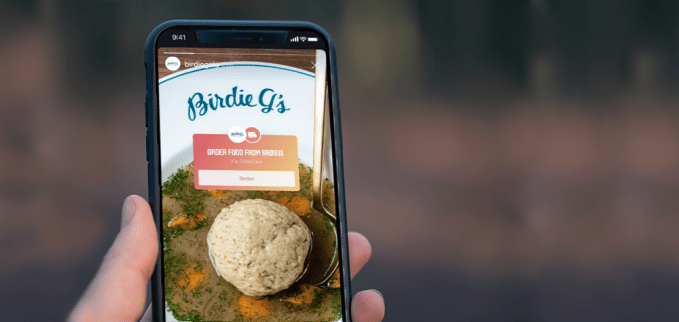
Powered by WPeMatico
A coalition of EU scientists and technologists that’s developing what’s billed as a “privacy-preserving” standard for Bluetooth-based proximity tracking, as a proxy for COVID-19 infection risk, wants Apple and Google to make changes to an API they’re developing for the same overarching purpose.
The Pan-European Privacy-Preserving Proximity Tracing (PEPP-PT) uncloaked on April 1, calling for developers of contact tracing apps to get behind a standardized approach to processing smartphone users’ data to coordinate digital interventions across borders and shrink the risk of overly intrusive location-tracking tools gaining momentum as a result of the pandemic.
PEPP-PT said today it has seven governments signed up to apply its approach to national apps, with a claimed pipeline of a further 40 in discussions about joining.
“We now have a lot of governments interacting,” said PEPP-PT’s Hans-Christian Boos, speaking during a webinar for journalists. “Some governments are publicly declaring that their local applications will be built on top of the principles of PEPP-PT and also the various protocols supplied inside this initiative.
“We know of seven countries that have already committed to do this — and we’re currently in conversation with 40 countries that are in various states of onboarding.”
Boos said a list of the governments would be shared with journalists, though at the time of writing we haven’t seen it. But we’ve asked PEPP-PT’s PR firm for the info and will update this report when we get it.
“The pan-European approach has worked,” he added. “Governments have decided at a speed previously unknown. But with 40 more countries in the queue of onboarding we definitely have outgrown just the European focus — and to us this shows that privacy as a model and as a discussion point… is a statement and it is something that we can export because we’re credible on it.”
Paolo de Rosa, the CTO at the Ministry of Innovation Technology and Digital Transformation for the Italian government, was also on the webinar — and confirmed its national app will be built on top of PEPP-PT.
“We will have an app soon and obviously it will be based on this model,” he said, offering no further details.
PEPP-PT’s core “privacy-preserving” claim rests on the use of system architectures that do not require location data to be collected. Rather devices that come near each other would share pseudonymized IDs — which could later be used to send notifications to an individual if the system calculates an infection risk has occurred. An infected individual’s contacts would be uploaded at the point of diagnosis — allowing notifications to be sent to other devices with which had come into contact.
Boos, a spokesman for and coordinator of PEPP-PT, told TechCrunch earlier this month the project will support both centralized and decentralized approaches. The former meaning IDs are uploaded to a trusted server, such as one controlled by a health authority; the latter meaning IDs are held locally on devices, where the infection risk is also calculated — a backend server is only in the loop to relay info to devices.
It’s just such a decentralized contacts tracing system that Apple and Google are collaborating on supporting — fast-following PEPP-PT last week by announcing a plan for cross-platform COVID-19 contacts tracing via a forthcoming API and then a system-wide (opt-in) for Bluetooth-based proximity tracking.
That intervention, by the only two smartphone platforms that matter when the ambition is mainstream adoption, is a major development — putting momentum behind decentralized contacts tracing for responding digitally to the coronavirus crisis in the Western world, certainly at the platform level.
In a resolution passed today the European parliament also called for a decentralized approach to COVID-19 proximity tracking.
MEPs are pushing for the Commission and Member States to be “fully transparent on the functioning of contact tracing apps, so that people can verify both the underlying protocol for security and privacy and check the code itself to see whether the application functions as the authorities are claiming.” (The Commission has previously signaled a preference for decentralization too.)
However, backers of PEPP-PT, which include at least seven governments (and the claim of many more), aren’t giving up on the option of a “privacy-preserving” centralized option — which some in their camp are dubbing “pseudo-decentralized” — with Boos claiming today that discussions are ongoing with Apple and Google about making changes to their approach.
As it stands, contacts tracing apps that don’t use a decentralized infrastructure won’t be able to carry out Bluetooth tracking in the background on Android or iOS — as the platforms limit how general apps can access Bluetooth. This means users of such apps would have to have the app open and active all the time for proximity tracking to function, with associated (negative) impacts on battery life and device usability.
There are also (intentional) restrictions on how contacts tracing data could be centralized, as a result of the relay server model being deployed in the joint Apple-Google model.
“We very much appreciate that Google and Apple are stepping up to making the operating system layer available — or putting what should be the OS actually there, which is the Bluetooth measurement and the handling of crypto and the background running of such tasks which have to keep running resiliently all the time — if you look at their protocols and if you look at whom they are provided by, the two dominant players in the mobile ecosystem, then I think that from a government perspective especially, or from lots of government perspectives, there are many open points to discuss,” said Boos today.
“From a PEPP-PT perspective there are a few points to discuss because we want choice and implementing choice in terms of model — decentralized or centralized on top of their protocol creates actually the worst of both worlds — so there are many points to discuss. But contrary to the behavior that many of us who work with tech companies are used to Google and Apple are very open in these discussions and there’s no point in getting up in arms yet because these discussions are ongoing and it looks like agreement can be reached with them.”
It wasn’t clear what specific changes PEPP-PT wants from Apple and Google — we asked for more detail during the webinar but didn’t get a response. But the group and its government backers may be hoping to dilute the tech giants’ stance to make it easier to create centralized graphs of Bluetooth contacts to feed national coronavirus responses.
As it stands, Apple and Google’s API is designed to block contact matching on a server — though there might still be ways for governments (and others) to partially work around the restrictions and centralize some data.
We reached out to Apple and Google with questions about the claimed discussions with PEPP-PT. At the time of writing, neither had responded.
As well as Italy, the German and French governments are among those that have indicated they’re backing PEPP-PT for national apps — which suggests powerful EU Member States could be squaring up for a fight with the tech giants, along the lines of Apple versus the FBI, if pressure to tweak the API fails.
Another key strand to this story is that PEPP-PT continues to face strident criticism from privacy and security experts in its own backyard — including after it removed a reference to a decentralized protocol for COVID-19 contacts tracing that’s being developed by another European coalition, comprised of privacy and security experts, called DP-3T.
Coindesk reported on the silent edit to PEPP-PT’s website yesterday.
Backers of DP-3T have also repeatedly queried why PEPP-PT hasn’t published code or protocols for review to-date — and even gone so far as to dub the effort a “trojan horse.”
#DP3T entered as a candidate to so-called PEPP-PT in good faith, but it is now clear that powerful actors pushing centralised databases of Bluetooth contact tracing do not, and will not, act in good faith.
PEPP-PT is a Trojan horse.
— Michael Veale (@mikarv) April 16, 2020
ETH Zürich’s Dr. Kenneth Paterson, who is both a part of the PEPP-PT effort and a designer of DP-3T, couldn’t shed any light on the exact changes the coalition is hoping to extract from “Gapple” when we asked.
“They’ve still not said exactly how their system would work, so I can’t say what they would need [in terms of changes to Apple and Google’s system],” he told us in an email exchange.
Today Boos couched the removal of the reference to DP-3T on PEPP-PT’s website as a mistake — which he blamed on “bad communication.” He also claimed the coalition is still interested in including the former’s decentralized protocol within its bundle of standardized technologies. So the already sometimes fuzzy lines between the camps continue to be redrawn. (It’s also interesting to note that press emails to Boos are now being triaged by Hering Schuppener, a communications firm that sells publicity services, including crisis PR.)
“We’re really sorry for that,” Boos said of the DP-3T excision. “Actually we just wanted to put the various options on the same level that are out there. There are still all these options and we very much appreciate the work that colleagues and others are doing.
“You know there is a hot discussion in the crypto community about this and we actually encourage this discussion because it’s always good to improve on protocols. What we must not lose sight of is… that we’re not talking about crypto here, we’re talking about pandemic management and as long as an underlying transport layer can ensure privacy that’s good enough because governments can choose whatever they want.”
Boos also said PEPP-PT would finally be publishing some technical documents this afternoon — opting to release information some three weeks after its public unveiling and on a Friday evening (a seven-page ‘high level overview’ has since been put on their GitHub here [this link has since been deleted – Ed.] — but still a far cry from code for review) — while making a simultaneous plea for journalists to focus on the “bigger picture” of fighting the coronavirus rather than keep obsessing over technical details.
During today’s webinar some of the scientists backing PEPP-PT talked about how they’re testing the efficacy of Bluetooth as a proxy for tracking infection risk.
“The algorithm that we’ve been working on looks at the cumulative amount of time that individuals spend in proximity with each other,” said Christophe Fraser, professor at the Nuffield Department of Medicine and Senior Group Leader in Pathogen Dynamics at the Big Data Institute, University of Oxford, offering a general primer on using Bluetooth proximity data for tracking viral transmission.
“The aim is to predict the probability of transmission from the phone proximity data. So the ideal system reduces the requested quarantine to those who are the most at risk of being infected and doesn’t give the notification — even though some proximity event was recorded — to those people who’re not at risk of being infected.”
“Obviously that’s going to be an imperfect process,” he went on. “But the key point is that in this innovative approach that we should be able to audit the extent to which that information and those notifications are correct — so we need to actually be seeing, of the people who have been sent the notification how many of them actually were infected. And of those people who were identified as contacts, how many weren’t.
“Auditing can be done in many different ways for each system but that step is crucial.”
Evaluating the effectiveness of the digital interventions will be vital, per Fraser — whose presentation could have been interpreted as making a case for public health authorities to have fuller access to contacts graphs. But it’s important to note that DP-3T’s decentralized protocol makes clear provision for app users to opt-in to voluntarily share data with epidemiologists and research groups to enable them to reconstruct the interaction graph among infected and at risk users (aka to get access to a proximity graph).
“It’s really important that if you’re going to do an intervention that is going to affect millions of people — in terms of these requests to [quarantine] — that that information be the best possible science or the best possible representation of the evidence at the point at which you give the notification,” added Fraser. “And therefore as we progress forwards that evidence — our understanding of the transmission of the virus — is going to improve. And in fact auditing of the app can allow that to improve, and therefore it seems essential that that information be fed back.”
None of the PEPP-PT-aligned apps that are currently being used for testing or reference are interfacing with national health authority systems, per Boos — though he cited a test in Italy that’s been plugged into a company’s health system to run tests.
“We have supplied the application builders with the backend, we have supplied them with sample code, we have supplied them with protocols, we have supplied them with the science of measurement, and so on and so forth. We have a working application that simply has no integration into a country’s health system — on Android and on iOS,” he noted.
On its website PEPP-PT lists a number of corporate “members” as backing the effort — including the likes of Vodafone — alongside several research institutions including Germany’s Fraunhofer Heinrich Hertz Institute for telecoms (HHI) which has been reported as leading the effort.
The HHI’s executive director, Thomas Wiegand, was also on today’s call. Notably, his name initially appeared on the authorship list for the DP-3T’s white paper. However, on April 10 he was removed from the README and authorship list, per its GitHub document history. No explanation for the change was given.
During today’s press conference Wiegand made an intervention that seems unlikely to endear him to the wider crypto and digital rights community — describing the debate around which cryptography system to use for COVID-19 contacts tracing as a ‘side show’ and expressing concern that what he called Europe’s “open public discussion” might “destroy our ability to get ourselves as Europeans out of this.”
“I just wanted to make everyone aware of the difficulty of this problem,” he also said. “Cryptography is only one of 12 building blocks in the system. So I really would like to have everybody go back and reconsider what problem we are in here. We have to win against this virus… or we have another lockdown or we have a lot of big problems. I would like to have everybody to consider that and to think about it because we have a chance if we get our act together and really win against the virus.”
The press conference had an even more inauspicious start after the Zoom call was disrupted by racist spam in the chat field. Right before that Boos had kicked off the call saying he had heard from “some more technically savvy people that we should not be using Zoom because it’s insecure — and for an initiative that wants security and privacy it’s the wrong tool.”
“Unfortunately we found out that many of our international colleagues only had this on their corporate PCs so over time either Zoom has to improve — or we need to get better installations out there. It’s certainly not our intention to leak the data on this Zoom,” he added.
Powered by WPeMatico
Would you pay with a “Google Card?” TechCrunch has obtained imagery that shows Google is developing its own physical and virtual debit cards. The Google card and associated checking account will allow users to buy things with a card, mobile phone or online. It connects to a Google app with new features that let users easily monitor purchases, check their balance or lock their account. The card will be co-branded with different bank partners, including CITI and Stanford Federal Credit Union.
A source provided TechCrunch with the images seen here, as well as proof that they came from Google. Another source confirmed that Google has recently worked on a payments card that its team hopes will become the foundation of its Google Pay app — and help it rival Apple Pay and the Apple Card. Currently, Google Pay only allows online and peer-to-peer payments by connecting a traditionally issued payment card. A “Google Pay Card” would vastly expand the app’s use cases, and Google’s potential as a fintech giant.
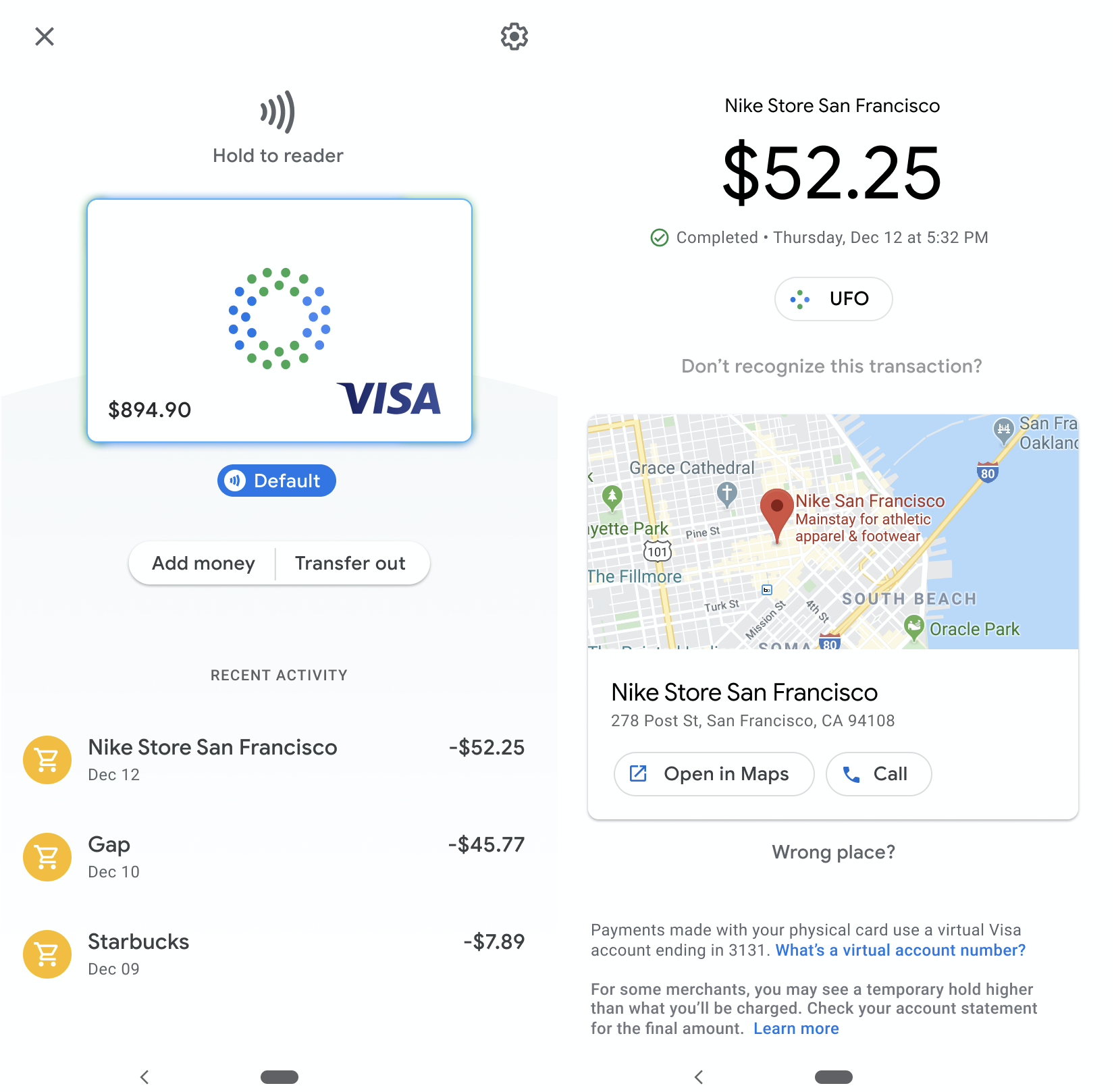
By building a smart debit card, Google has the opportunity to unlock new streams of revenue and data. It could potentially charge interchange fees on purchases made with the card or other checking account fees, and then split them with its banking partners. Depending on its privacy decisions, Google could use transaction data on what people buy to improve ad campaign measurement or even targeting. Brands might be willing to buy more Google ads if the tech giant can prove they drive a sales lift.
The long-term implications are even greater. While once the industry joke was that every app eventually becomes a messaging app, more recently it’s been that every tech company eventually becomes a financial services company. A smart debit card and checking accounts could pave the way for Google offering banking, stock brokerage, financial advice or robo-advising, accounting, insurance or lending.

Image Credits: jossnatu / Getty Images
Google’s vast access to data could allow it to more accurately manage risk than traditional financial institutions. Its deep connection to consumers via apps, ads, search and the Android operating system gives it ample ways to promote and integrate financial services. With the COVID-19 downturn taking shape, high-margin finance products could help Google develop efficient revenue opportunities and build its share price back up.
When TechCrunch asked Google for confirmation, it did not dispute our findings or assertions. The company offered us a statement it provided reporters following a November story, wherein Google told The Wall Street Journal’s Peter Rudegeair and Liz Hoffman it was experimenting in the checking account space. TechCrunch is the first to report Google’s debit card plans:
We’re exploring how we can partner with banks and credit unions in the US to offer smart checking accounts through Google Pay, helping their customers benefit from useful insights and budgeting tools, while keeping their money in an FDIC or NCUA-insured account. Our lead partners today are Citi and Stanford Federal Credit Union, and we look forward to sharing more details in the coming months.
For now, Google’s strategy is to let partnered banks and credit unions provide the underlying financial infrastructure and navigate regulation while it builds smarter interfaces and user experiences. It’s forseeable that one day Google might cut out the banks and take all the spoils for itself. Google launched a Wallet debit card in 2013 as an extension of its old payment app Google Wallet, but shut the card down in 2016. Given Google’s penchant for renaming or shutting down then reviving products, building a new debit card feels on-brand.
With people around the world suddenly more concerned about their finances amidst the coronavirus economic disaster, a debit card with more transparency and controls could be appealing.
Traditional banking products can be clunky, often requiring phone communication with customer service or sifting through cluttered websites to address security issues. Google hopes to make financial management as intuitive as its email and mapping apps. The card and app designs shown here are not final, and it’s unclear when Google’s debit card may launch. But let’s take a look at what these internal Google materials reveal about its ambitions for its payment instrument.

The Google debit card will come co-branded with the Google name and its partnered bank, though the exact name of the product is still unknown. In the designs, it’s a chip card on the Visa network, though Google could potentially support other networks like Mastercard. Users are able to add money or transfer funds out of their account from the connected Google app, which is likely to be Google Pay, and use a fingerprint and PIN for account security.
Once connected to their bank or credit union account, users could pay for purchases in retail stores with a physical Google debit card, including with contactless payments, by just holding it up to a card reader. A virtual version of the card that lives on a user’s phone can also be used for Bluetooth mobile payments. Meanwhile, a virtual card number can be used for online or in-app payments.

Users are shown a list of recent transactions, with each including the merchant name, date and price. They can dig into each transaction to see the location on a map, get directions or call the store. If users don’t recognize a transaction, it’s easy to protect themselves with the card’s vast security options.
If a customer suspects foul play because they lost their card, they can lock it and optionally order a replacement while still being able to pay with their phone or online, thanks to Google’s virtual card number system that’s different than the one on their physical card. If instead they suspect their virtual card number was stolen by a hacker, they can quickly reset it. And if they believe someone has gained unauthorized access to their account, they can lock it entirely to block all types of payments and transfers.
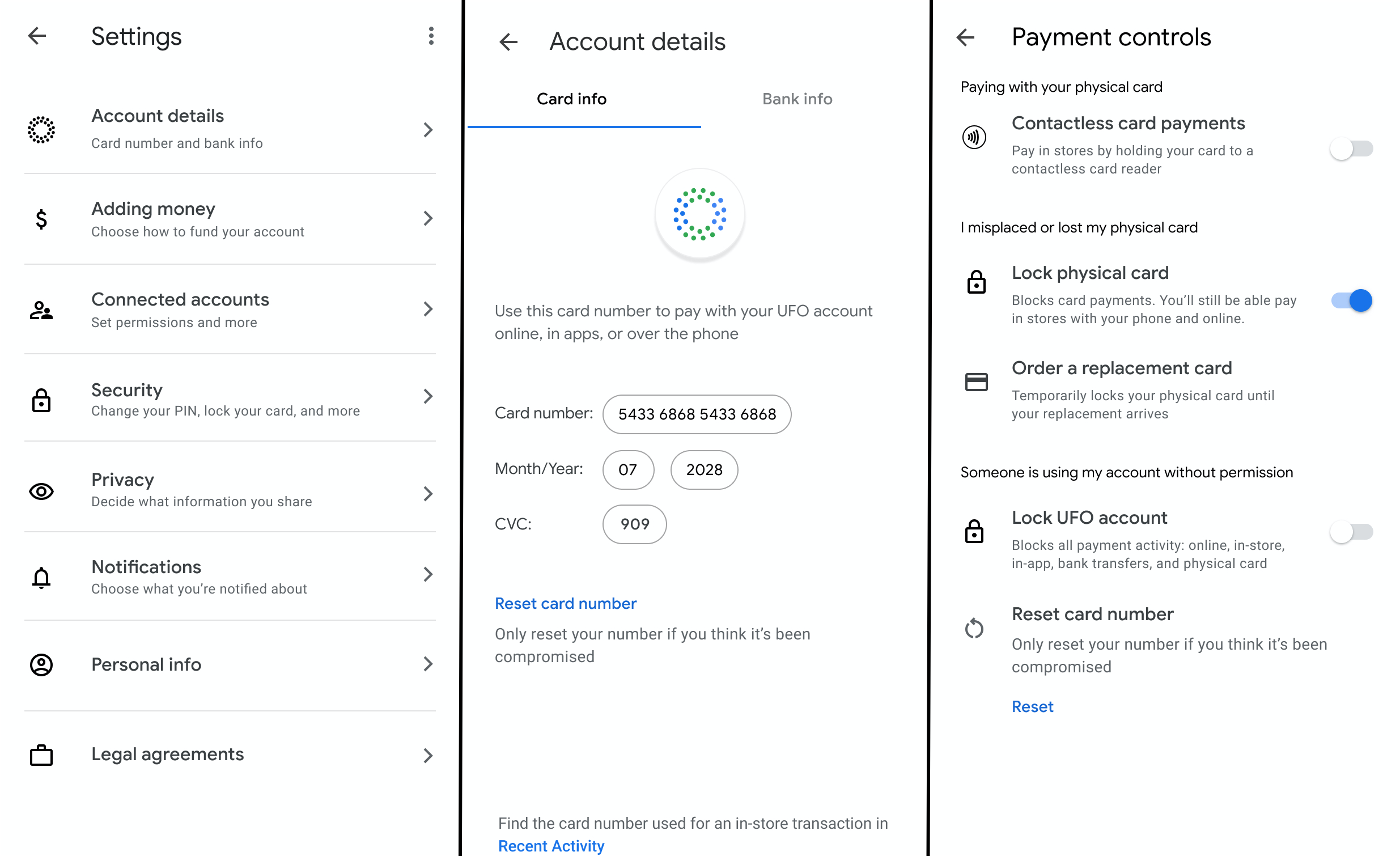
The settings reveal options for notifications and privacy controls to “decide what information you share,” though we don’t have imagery of what’s contained in those menus. It’s unclear how much power Google will give customers to limit the company or merchant’s data access. Google’s decisions there could impact how transaction data might fuel its other businesses.
Google is a relative late-comer to offering its own card. Apple launched its Apple Card in August, offering a slickly designed titanium Mastercard credit card backed by Goldman Sachs. It charges minimal customer fees, comes with a virtual card for use through Apple Pay and generates interest.

Apple Card
Apple does collect interchange fees from merchants, though, which Google could similarly gather to earn revenue. Last month, Apple changed the Card’s privacy settings to share more data with Goldman Sachs that might also help the two provide additional financial services. Apple Pay now accounts for 5% of global card transactions, and is forecast to hit 10% by 2024, according to Bernstein research. The underlines the gigantic market Google is gunning for here.
The stock brokerage and robo-advisor apps have also joined the payments race. Wealthfront launched cash accounts and debit cards last February, bringing in $1 billion in assets in two months and doubling the company’s total holdings to $20 billion by September. Betterment launched its checking product in October 2019 with a Visa debit card, but it doesn’t generate interest.
Robinhood botched the December 2018 launch of its checking accounts due to ineligible insurance, but relaunched in October 2019 with debit card withdrawls from 75,000 ATMs and a solid interest rate. It’s unclear how Google’s card will work with ATMs or how its checking accounts will generate interest.

Robinhood’s debit cards
The appeal for Google and the rest is clear. It seems whenever companies help move people’s money around, some of it inevitably “falls off the truck” and lands in their pockets. Financial services are typically low-overhead ways to generate revenue. That could be especially enticing, as Google has found many of its side hustle “other bets” to be unsustainable. It’s moved to prune some of these tertiary projects, such as its Makani wind energy kites.
Google may never find businesses as lucrative as its core in search and advertising, but it has the advantages to become a serious player in fintech. Its vast sums of cash, deep bench of engineering talent, experience building complex utilities, numerous consumer touch points and near-bottomless well of data could give it an edge over stodgier old banks and scrappier startups. And while Facebook slams into regulatory scrutiny and is forced to scale back its Libra cryptocurrency, Google’s more familiar approach via debit cards could pay off.
Powered by WPeMatico
Media software maker Plex has released two new projects today from its internal R&D group, Plex Labs. One is an updated take on the classic Winamp player it calls Plexamp, and another is a dedicated app for Plex server administration. The projects are meant to appeal largely to Plex power users who take full advantage of Plex’s software suite, which has grown over time from being only a home media solution to a one-stop shop for everything from live TV to streaming audio.
The first of the new apps, Plexamp, is actually a revamp of the first Plex Labs project released. In December 2017, Plex introduced its own music player, whose name Plexamp was a nod to the Winamp player it aimed to replace. The project, like others from Plex Labs, was built by Plex employees in their spare time.
The goal with the original Plexamp was to offer a small desktop player that could handle any music format. The app let you use media keys for playing, pausing and skipping tracks and it worked offline when the Plex server ran on your laptop. It also offered visualizations to accompany your music that pulled from the album art.
While the original app ran on Mac or Windows, the new release works across five platforms, now including iOS, Android and Linux.
The app itself has been completely redone, as well — rewritten from scratch, in fact. And it’s tied to Plex’s subscription service, Plex Pass — meaning you’ll need to be a paying customer to use it.
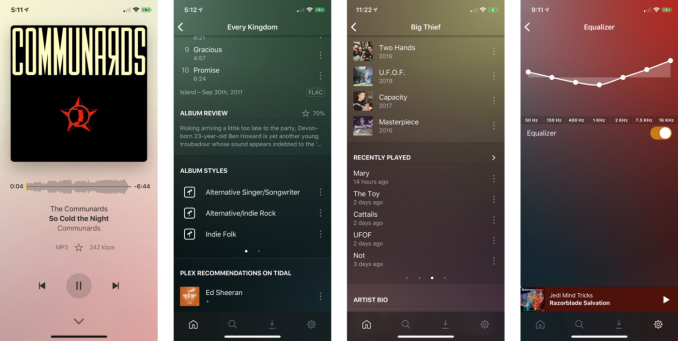
The company explains the original version of Plexamp had issues around portability and licensing; it didn’t have an easy way to add functionality; and it was built with React, which tied it to the web.
To create the new Plexamp (version 3.0), Plex built an audio player library called TREBLE on top of a low-level commercial audio engine. TREBLE has been shipping in Plex’s commercial applications, but this release brings it to Plexamp. The addition helped make the app portable across almost all desktop and mobile platforms, as was it being rewritten in React Native.
The new app provides features Plex Pass music listeners want, like gapless playback, high-quality resampling, Sweet Fades (Plex’s “smart” alternative to crossfades) soft transitions and pre-caching. Plex also added a few more effects, including one for voice boosting spoken word audio and another for silence compression.
But the app really sells itself to longtime Plex users, as Plexamp lets you go back to see your own “top personal charts” for what you’ve listened to the most in years past. (Sort of like a Plex version of Apple Music’s Replay playlists).

Plexamp 3.0 also introduces a feature that lets you build your own mixes by picking a set of artists. Plus it offers a more expansive list of stations, supports offline listening and improves its search functionality.
The new Recent Searches area, for example, will save your search results from across servers, as well as TIDAL and podcasts. And a new Recent Plays feature shows you the music you consciously chose to play, again including across all servers and TIDAL.

There are some little touches, too, that show the personal care that went into the app’s design — like the way Plexamp uses album art and a process called “UltraBlur” to give each artist and alum page its own look. Or how there are options for light and dark — and lighter and darker — themes.
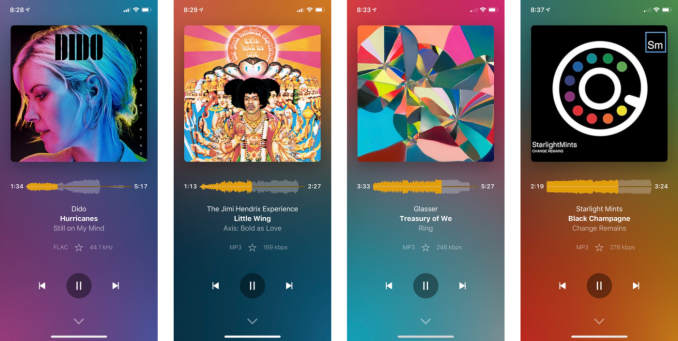
The other big new release from Plex Labs is the new Plex Dash app.
This mobile and tablet app lets you keep a close eye on your personal media server, including a way to see all playbacks even across multiple servers, plus other administrative features.
With Plex Dash, you can edit your artwork, scan for new media, fix incorrect matches, check on server resource usage, tweak library settings and view server logs live.
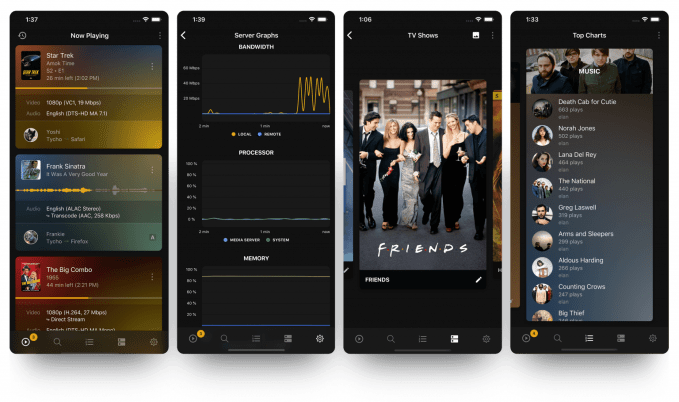 Plex suggests you it run on the iPad you have mounted in the wall — like in your fancy media room, I guess — but for us poorer folks, it runs on your smartphone, too.
Plex suggests you it run on the iPad you have mounted in the wall — like in your fancy media room, I guess — but for us poorer folks, it runs on your smartphone, too.
It’s a power user tool, but one that will be welcomed for those fully immersed in a Plex-run home media setup. (And also a good way to respond to criticism that Plex is too focused today on its streaming and TV options, and not its core home media software customer base.)
Like Plexamp, the new Plex Dash requires a Plex Pass subscription and runs on iOS and Android.
The apps launched today are notable as they’re the first to arrive from Plex Labs since the original release of Plexamp in 2017 and because they require a subscription in order to work.
Plex at the end of 2019 said it had 15 million registered households using its service. Though the service is profitable, only a small percentage are paid subscribers. New apps with extra features, then, could convince more Plex users to upgrade.
Powered by WPeMatico
Google is today announcing a series of policy changes aimed at eliminating untrustworthy apps from its Android app marketplace, the Google Play store. The changes are meant to give users more control over how their data is used, tighten subscription policies and help prevent deceptive apps and media — including those involving deepfakes — from becoming available on the Google Play Store.
Background Location
The first of these new policies is focused on the location tracking permissions requested by some apps.
Overuse of location tracking has been an area Google has struggled to rein in. In Android 10, users were able to restrict apps’ access to location while the app was in use, similar to what’s been available on iOS. With the debut of Android 11, Google decided to give users even more control with the new ability to grant a temporary “one-time” permission to sensitive data, like location.
In February, Google said it would also soon require developers to get user permission before accessing background location data, after noting that many apps were asking for unnecessary user data. The company found that a number of these apps would have been able to provide the same experience to users if they only accessed location while the app was in use — there was no advantage to running the app in the background.
Of course, there’s an advantage for developers who are collecting location data. This sort of data can be sold to third-party through trackers that supply advertisers with detailed information about the app’s users, earning the developer additional income.
The new change to Google Play policies now requires that developers get approval to access background location in their apps.
But Google is giving developers time to comply. It says no action will be taken for new apps until August 2020 or on existing apps until November 2020.
“Fleeceware”
A second policy is focused on subscription-based apps. Subscriptions have become a booming business industry-wide. They’re often a better way for apps to generate revenue as opposed to other monetization methods — like paid downloads, ads or in-app purchases.
However, many subscription apps are duping users into paying by not making it easy or obvious how to dismiss a subscription offer in order to use the free parts of an app, or not being clear about subscription terms or the length of free trials, among other things.
The new Google Play policy says developers will need to be explicit about their subscription terms, trials and offers, by telling users the following:
That means the “fine print” has to be included on the offer’s page, and developers shouldn’t use sneaky tricks like lighter font to hide the important bits, either.
For example:
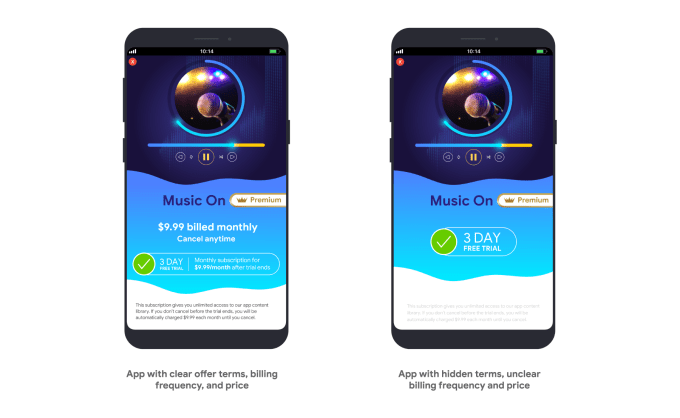
This change aims to address the rampant problem with “fleeceware” across the Google Play store. Multiple studies have shown subscription apps have gotten out of control. In fact, one study from January stated that over 600 million Android users had installed “fleeceware” apps from the Play Store. To be fair, the problem is not limited to Android. The iOS App Store was recently found to have an issue, too, with more than 3.5 million users having installed “fleeceware.”
Developers have until June 16, 2020 to come into compliance with this policy, Google says.
Deepfakes
The final update has to do with the Play Store’s “Deceptive Behavior” policy.
This wasn’t detailed in Google’s official announcements about the new policies, but Google tells us it’s also rolling out updated rules around deceptive content and apps.
Before, Google’s policy was used to restrict apps that tried to deceive users — like apps claiming a functionally impossible task, those that lied in their listing about their content or features or those that mimicked the Android OS, among others.
The updated policy is meant to better ensure all apps are clear about their behavior once they’re downloaded. In particular, it’s meant to prevent any manipulated content (aka “deepfakes”) from being available on the Play Store.
Google tells us this policy change won’t impact apps that allow users to make deepfakes that are “for fun” — like those that allow users to swap their face onto GIFs, for example. These will fall under an exception to the rule, which allows deepfakes that are “obvious satire or parody.”
However, it will take aim at apps that manipulate and alter media in a way that isn’t conventionally obvious or acceptable.
For example:
In particular, the policy will focus on apps that promote misleading imagery that could cause harm related to politics, social issues or sensitive events. The apps must also disclose or watermark the altered media if it isn’t clear the media has been altered.
Similar bans on manipulated media have been enacted across social media platforms, including Facebook, Twitter and WeChat. Apple’s App Store Developer Guidelines don’t specifically reference “deepfakes” by name, however, though it bans apps with false or defamatory information, outside of satire and humor.
Google says the apps currently available on Google Play have 30 days to comply with this change.
In Google’s announcement, the company said it understood these were difficult times for people, which is why it’s taken steps to minimize the short-term impact of these changes. In other words, it doesn’t sound like the policy changes will soon result in any mass banning or big Play Store clean-out — rather, they’re meant to set the stage for better policing of the store in the future.
Powered by WPeMatico
Google today is making it easier for families to find quality educational apps with the addition of a new “Teacher Approved” section to Google Play. All apps found in this section are vetted by a panel of reviewers, including more than 200 teachers across the U.S., and meet Google’s existing requirements for its “Designed for Families” program.
That program requires apps to meet government regulations around data collection and ad targeting, and also limits the types of ads that can be displayed to children, if apps are ad-supported.
The apps chosen for the “Teacher Approved” section, however, don’t just meet the program’s minimum requirements — they’re also reviewed and rated highly by teachers. These may be apps teachers suggest for supplemental learning while others may just be used for fun.
The launch arrives at a time when most U.S. children are now out of school due to the COVID-19 pandemic and the subsequent school closures. To date, at least 55.1 million students are no longer attending their public or private school in-person, according to data from the National Center for Education Statistics. This change has left parents scrambling to fill their child’s time with educational activities. And even if distance learning is available in their school district, it isn’t typically enough to keep the child engaged throughout the day.
Google says it heard from parents that it was difficult to find kid-friendly apps they felt good about letting their children use, which is why it chose to launch the new “Teacher Approved” section on Google Play.
The company worked with academic experts, including lead advisors Joe Blatt (Harvard Graduate School of Education) and Dr. Sandra Calvert (Georgetown University) to create the framework for rating apps for kids. But the apps themselves are chosen by a panel with teacher involvement. The panel rates apps on various aspects like age-appropriateness, quality of experience, enrichment and whether kids enjoy using the app.
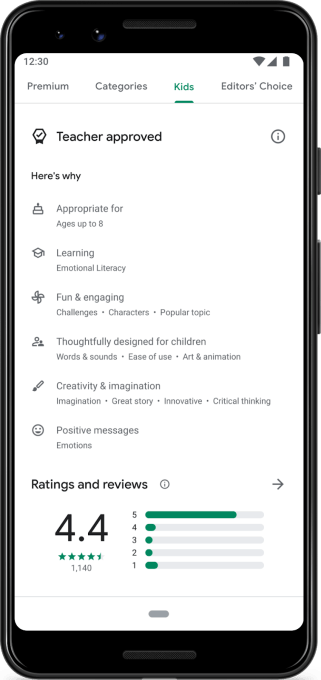
To access the new section, you can either visit the “Kids” tab on Google Play or you can look for the “Teacher Approved” badge on any given app to see if it met with teachers’ approval. In addition, Google Play Pass will offer subscribers a selection of “Teacher Approved” content under the “Apps and games for kids” section.
The apps will be grouped by age: 5 & under, ages 6-8 and ages 9-12. Google will also include information in the app’s listing about why it was rated highly.
At launch, Google tells us there will be around 1,000 Teacher Approved apps live in the Play Store and around 60 also included in Google Play Pass. The company says it’s working with its Play Pass partners to increase this number over time.
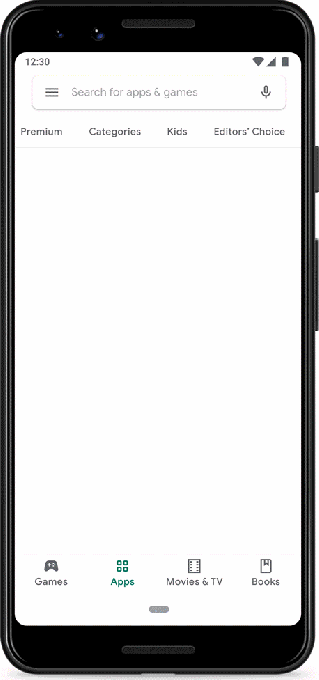
“I think it’s terrific that Google is taking this unprecedented stand – creating a unique space for apps that teachers have rated high in quality and value for kids and their families,” said Joe Blatt, senior lecturer and faculty director of the Technology, Innovation, and Education Program, in a statement about the launch. “Over the past three years, together with faculty colleagues and students, I have worked to pinpoint criteria for developmental appropriateness, learning impact, and appeal. Then we helped Google build a rating system that enables teachers to apply these criteria reliably. I’m really impressed with the dedication and professionalism that the Google team has invested in this project,” he added.
The new Kids tab with “Teacher approved” apps will roll out in the U.S. on Google Play over the next few days. Google says it will expand the experience internationally in the months to come.
Powered by WPeMatico
VSCO, the popular photo editing app and Instagram rival, is the latest company to undergo layoffs attributed to the COVID-19 crisis, which has put a strain on venture-backed startups. According to a report from NPR, which was then confirmed by VSCO co-founder and CEO Joel Flory on LinkedIn, the company is laying off around 30% of staff, or 45 of its employees.
Though Flory didn’t reference the COVID-19 outbreak by name, his post described the rapid change to the economy which necessitated the layoffs.
“2020 was staged to be a year where we would continue to forward invest into our business,” Flory wrote. “Overnight our environment changed. We realized that we would need to shift towards running a self-sustaining business.”
In other words, VSCO is anticipating a future where venture capital is less readily available and is making the shift toward running a business that’s no longer reliant on outside capital or funding in order to operate. By laying off a portion of staff, VSCO believes it will be able to sustain its business for many years.
To date, VSCO has raised $90 million in outside funding, and sees its app used by more than 20 million active users per week. However, a smaller portion of those users are customers who pay for a VSCO Membership that offers an expanded array of features, tools, presets and other content. VSCO confirmed to TechCrunch in February 2020 that it had around 2+ million paid subscribers.
Late last year, VSCO had said it was on pace to surpass 4 million paid subscribers by 2020 and was approaching $80 million in annual revenue. However, these projections were tied to VSCO’s forward investment this year, and the shift towards becoming self-sustainable will impact these numbers, the company says.
PitchBook data valued the business at $550 million, NPR also reported — a number that’s made the rounds before, as well.

In 2020, VSCO has rolled out several features designed to better support video editing. It gave creators the ability to publish their video edits to the VSCO feed, and last month, for example, launched a more powerful and feature-rich video editing tool called Montage. The latter was meant to grow VSCO’s paid subscriber base, as it requires users to pay in order to save and publish their finished videos.
VSCO’s profile has also been raised beyond its core user base in recent months, after it became associated with a Gen Z meme that circulated on sites like TikTok.
Though perhaps not the marketing the company would have desired, the VSCO girl meme became a way to mock a certain type of girl — one who sports a messy bun, baggy shirts and scrunchies and carries around eco-conscious items like Hydro Flasks or metal straws. VSCO’s app for making your photos look good became associated with this persona, as it’s often used to filter and edit images in order to give them an aesthetic that teenage girls (VSCO girls) supposedly desired.
As for the layoffs, VSCO says its former employees will receive a minimum of seven weeks of severance pay, and a minimum of two months of COBRA health coverage. In terms of equity, VSCO is pro-rating stock option vesting and extending equity exercise periods post-term, it also notes.
Flory’s LinkedIn post additionally offered a way for those interested in hiring the laid-off VSCO employees to reach the company. He said the jobs@vsco.co email address could be used to make inquires about hiring its talent. The company will also be working to provide other job placement resources and support, it says.
“I am deeply saddened to let some incredible people go and am so grateful for everything they’ve done for VSCO and our community,” Flory wrote. “Our mission and vision remain unchanged. Our ability to provide a place for creative expression, inspiration and connection is even more important than ever right now,” he added.
Powered by WPeMatico